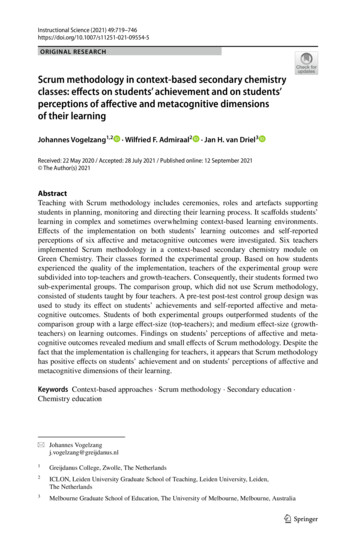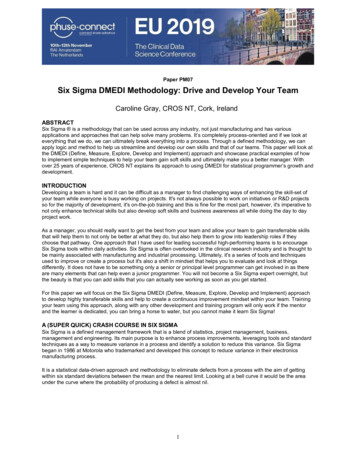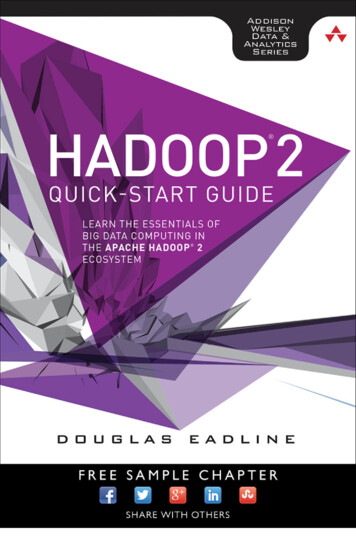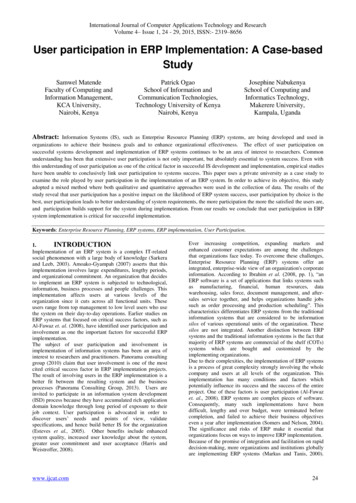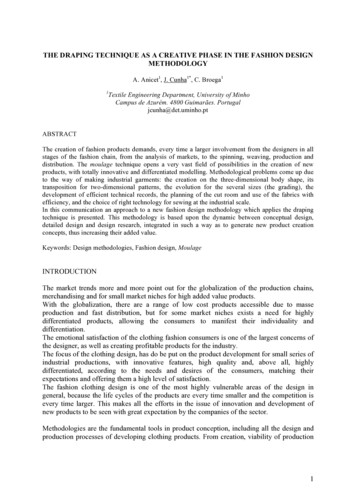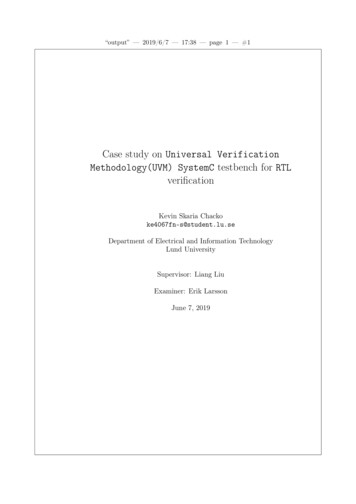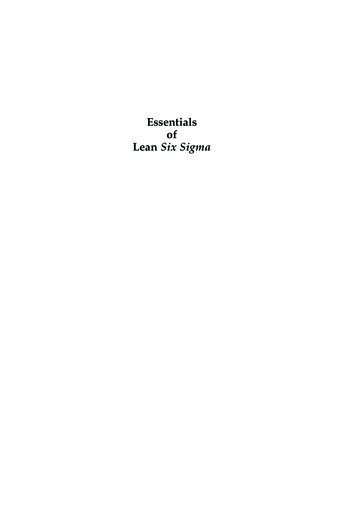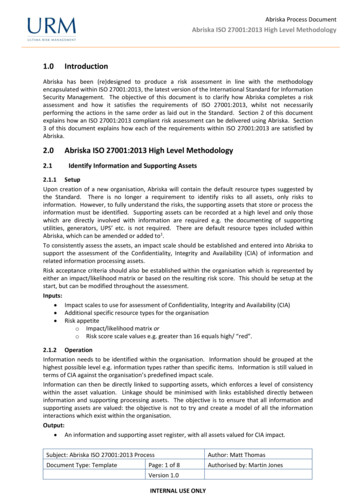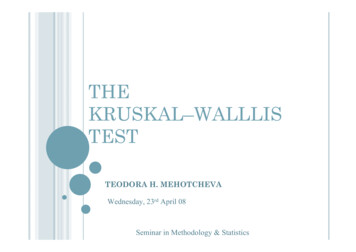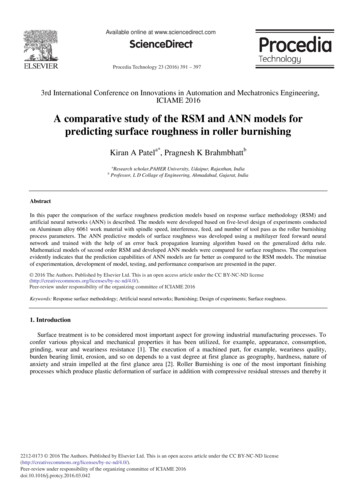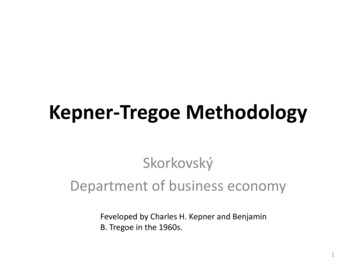
Transcription
Kepner-Tregoe MethodologySkorkovskýDepartment of business economyFeveloped by Charles H. Kepner and BenjaminB. Tregoe in the 1960s.1
Apollo 13 – Houston, Houston, do you read me ?We have a big problem .!The Apollo 13 team is famous for bringing back the astronauts stranded inspace by solving difficult and complex problems. The teams solving theproblems has used the Kepner-Tregoe (KT) methodology !2
Decision Analysis –serious oneSticky- lepkavýLick – olíznout3
What is it K-T methodology ?Kepner Tregoe is used for decision making .It is a structured methodology for gathering information and prioritizing andevaluating it.It is very detailed and complex method applicable in many areas, whichis much broader than just idea selection.It is called also a root cause analysis and decision-making method.It is a step-by-step approach for systematically solving problems, makingdecisions, and analyzing potential risks.4
Access situation (situation appraisal) Identify concerns (problems) by listing them Separate the level of concern (importance, magnitude,level of influence) Set the priority level to measure seriousness ofimpacts (influence), urgency and growth potential Decide what action to take next (step by step approach) Plan for who is involved, what they will be doing,where they will be involved, when it happenedand the extent of involvement (magnitude)5
WHO WHAT WHEN WHERE EXTENT6
Make decision(A choice between two or more alternatives) Identify what is being decided Establish and classify objectives (main ones, minor ones,.) Separate the objectives into must (must to have) and want (nice to have)categories (we have to assign importance factors from 1-10, where 10 isthe most important want objective) and assign criterion rating (weights) Generate the alternatives (we can do it that way or we can take another wayas well) Evaluate the alternatives by scoring the wants against themain objective – see next slides Review adverse (harmful) consequences of your correctivesteps (risk evaluation, risk assessment) Make the best possible choice what to do7
Criteria ratingSee similar example on the next slideImportance can be understood as a Satisfaction score,meaning desirable but not essential.Criteria rating is related to want criteria and every car property8
Which car to buy ?Criterion ratingImportance score, meaningdesirable but not essential.go to slide 34 and back9
See the Upcoming (approaching, next to come) andPotential Opportunity -Solutions State the actionList the potential opportunities O{op1, op2 ,.,opN}Consider the possible solutions (e.g. the second one)Take the action to address the likelycause/solution Prepare actions to enhance likely (possible)effects10
Uncover and handle problems(problem analysis) State the problem (definition and description of the problem) Specify the problem by asking what is and whatis not Develop possible causes of the problem Test and verify possible causes Determine the most probable cause (root cause) Verify any assumptions Try the best possible solution and monitor whatwill be a situation after applied correctives step11
roblem 1Problem WhatWhereWhenExtentSolution (corrective action) 1Solution (corrective action) XProblem 1 Solution (corrective action) 1Solution (corrective action) YProblem N 12
Decomposition, priorities and causesSub-problem 1Priority1Sub-problem NPriority NProblem 1Problem 1Sub-problem 1Cause 1Sub-problem NCause NProblem 2Problem 213
Example of problem manifestation(decrease of performance)performancePlanned performanceUnfavourable deviationReal performanceWhat do we see, hear, feel,taste, or smell that tells usthere is a deviation?timeFinal effect of the PROBLEM (e.g. server crashed)Then we have to ask : What, Where, When, and to what Extent –Size (how much, how many)?14
Server crashed !!!! (home study !!!) Server crashed (this is a very poor problem definition)The e-mail system crashed after the 3rd shift support engineer appliedhot-fix XYZ to Exchange Server 123 (better definition of the problem)History (and best practice) says that the root cause of the problem is probably due tosome recent change. WHAT, WHERE, WHEN and EXTENT will be shown on next slides15
Test the Most Probable Cause(home study !!!)Clarifying problem Analysis (example)We have to ask (where Qi QUESTION i) :QuestionISIS NOTWhat (identify)Where (locate)When (timing)Extent (magnitude)Q1Q3Q5Q7Q2Q4Q6Q8See next slides16
Problem Analysis - WhatIs What specific object(s) hasthe deviation? What is the specificdeviation?Example for Is :1. What specific objectIS related to the defect?Inventory Valuation Objects in database A2. What specifically is the defect (deviation)?Inventory Adjustment does not work1- see setup of the database and see differences2- see algorithm used for calculation and parameters used.You can see , that in production calculation it dose not workIs Not What similar object(s) couldhave the deviation,, but doesnot? (It did not happennothappen))What other deviations couldbe reasonably observed,, butare not?not? (It did not happenhappen))Example for Is Not :1.What specific object IS NOT related to the defect?Inventory Valuation Objects in database B2. What specifically is not the defect (deviation)?1 - Setup has another parameters On2- Algorithm is used also for production where not erroroccurs17
See two MS Dynamics Setup screens(related to the problem specified recently)18
Problem Analysis - WhatIs What specific object(s) hasthe deviation? What is the specificdeviation? - bites on the neckExample for Is :1. Nice young girl s neck and strangelook of anemic personIs Not What similar object(s) couldhave the deviation,, but doesnot? (It did not happennothappen))What is the specific deviation?but does not? (It did nothappen)) – biteshappenbites,, anemiaExample of Is Not :1. Girl with garlic in her hands2. No bites3. Zaftig19
Another example for WHAT and IS andIS NOTExample I.Customer X and Customer Y both use product B butonly customer X was sent the wrong product so theobject IS Customer X , but IS NOT Customer YExample II.IS girl visited Dracula lower castle without a bunchof garlic, but IS NOT not the one having bunch ofgarlic and visiting Špiberk castle in Brno20
Problem Analysis - WhereIs NotIs Where is the object whenthe deviation is observed?(geographically) Where is the deviation onthe object? Example for Is :1. Old castle in the mountains (Romania)Where IS : Romanian Carpathian mountainswher It is very easy to meet a lot of vampiresthereWhere else could theobject be when thedeviation is observed,, butis not?Where else could thedeviation be located on theobject, but is not?Example for Is Not1.Brno castle SpilberkWhere IS NOT possible to meet vampires(only lovers and children and seniors)21
Problem Analysis - WhenIsIs Not When was the deviationobserved first (clock andcalendar time)? When since that time hasthe deviation beenobserved? When, in the object’shistory or life cycle, wasthe deviation observedfirst? See example next slideWhen else could thedeviation have beenobserved first,, but was not?When since that time couldthe deviation have beenobserved,, but was not?When else, in the object’shistory or life cycle, couldthe deviation have beenobserved first,, but was not?22
Example for WHEN and IS and IS NOTCustomer X and Customer Y both use product B butonly customer X was sent the wrong product ifSalesman Tony was on holiday in this time andSalesman Mustafa was in charge, so the object ISSalesman Mustafa , but IS NOT Salesman Tony23
Problem Analysis - ExtentIs NotIs How many objects havethe deviation? What is the size of a singledeviation? How many deviations areon each object? What is the trend? – Occurrences?– Size? How many objects couldhave the deviation, butdon’t?What other size could adeviation be, but isn’t?How many deviations couldthere be on each object,but are not?What could be the trend,but isn’t? Occurrences? Size?24
Problem AnalysisEvaluate Possible Causes Determine the most probable cause Which possible cause best explains the IS and IS NOTinformation? Which possible cause has the fewest, simplest, andmost reasonable assumptions?25
Problem AnalysisConfirm True Cause What can be done to verify any assumptionsmade? How can this cause be observed at work? How can we demonstrate the cause-andeffect relationship (e.g. Current Reality Tree or IshikawaFishbone Diagram)? When corrective action is taken, how willresults be checked?26
Let’s Look At Some Problems!27
Systematic Problem Solving and Decision making Overview28
Planning the Next Steps Problem Analysis Do we have a deviation? Is the cause unknown? Is it important to know the cause to take effectiveaction? If the answer is YES to ALL three, than youhave a big problem, Huston !!!29
Problem analysis table template(Home study)30
Problem description (example)On a new model of airplane, flight attendants develop rash onarms, hands, face (only those places). It only occurs on flightsover water.Usually disappears after 24 hours. No problems on old planesover those routes.Does not affect all attendants on these flights, but samenumber of attendants get it on each flight. Those who get rashhave no other ill effects.No measurable chemicals, etc., in cabin air.Rash arm - 31
Problem analysis real tableDistinction Difference32
Results ?33
Tree of the casual relationships I –example Decline of revenue due to : Lower merchantability of the items New competitors Change of the customer preferences Poor (not sufficient) quality of the item– Restriction of capacity production Downtime due to machine failure, obsolete machinery,irregular maintenance– Change of the legislation (change of the health rules)See tree34
RevenuedeclineDecline ofLowerproductiondemandNewcompetitorsChange of theLower qualitycustomer preferencesDecrease ofproductioncapacityMachinerydowntimes Change of thehealth rule Machinery is liableto breakdowns 35
Let’s Look At Some Problems again!36
Decision making process Problem definitionRequirements identificationGoal establishmentEvaluation criteria developmentSelect decision –making toolApply tool (K &T, Pros-Cons, )Check37
Step 1 and Step 2Step 1 Problem: Pick a replacement vehicle for the motor pool fleetThe definition of the problem dictates the requirements. As the vehicle is fora motor pool, the requirements will differ from those for a family car, forexample.Step 2 Requirements:1. Vehicle shall be made in U. S. A.2. Vehicle shall seat at least four adults, but no more than six adults3. Vehicle shall cost no more than 28,0004. Vehicle shall be new and the current model year38
MinMax 28000 USDMaxNew car(current model)39
Step 3 and Step 4Step 3 Goals:· Maximize passenger comfort· Maximize passenger safety· Maximize fuel-efficiency· Maximize reliability of the car· Minimize investment costStep 4 Alternatives:There are many alternatives but the requirements eliminate the considerationof a number of them:Requirement 1 eliminates the products not manufactured in the USARequirement 2 eliminates vans, buses, and sports cars (Ferrari no !!!!)Requirement 3 eliminates high-end luxury carsRequirement 4 eliminates used vehicles40
Step 5Step 5 Criteria:“Maximize comfort” will be based on the combined rear seat leg and shoulderroom. (Note: front seat passenger leg and shoulder room was found to be toonearly the same to discriminate among the alternatives.) 5“Maximize safety” will be based on the total number of stars awarded by theNational Highway Traffic Safety Administration for head-on and side impact. 10“Maximize fuel efficiency” will be based on the EPA fuel consumption for citydriving. 7“Maximize reliability” will be based on the reliability rating given each vehicle by aconsumer product testing company. 9“Minimize Cost” will be based on the purchase price. 10Weighted criteria vector C(5,10,7,9,10) are values assigned by decision makers !!!!41
Kepner-Tregoe table)(for 4 cars : Arrow, Baton, Carefree and Dash42
Last step – Validation (check)Last Step Validate Solution:The totals of the weighted scores show that the Dash most nearly meetsthe wants/goals (or put another way, has the most “benefits”). Dashmeets all the requirements and solves the problem !!!Go back to slide 943
Thanks for Your attention44
07.03.2013 · The Apollo 13 team is famous for bringing back the astronauts stranded in space by solving difficult and complex problems. The teams solving the problems has used the Kepner-Tregoe (KT) methodology ! 2 . Decision Analysis –serious one 3 Sticky- lepkavý Lick – olíznout. What is it K-T methodology ? Kepner Tregoe is used for decision making . It is a structured methodology for
